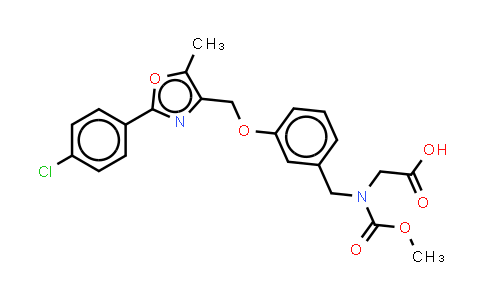| Chemical Name |
BMS-687453 |
| CAS Number |
1000998-59-3 |
| MDL Number |
MFCD18251482 |
| Molecular Formula |
C22H21ClN2O6 |
| Molecular Weight |
444.86 |
Introduction of 1000998-59-3 :
BMS-687453 is a potent and selective PPARα agonist, with an EC50 and IC50 of 10 nM and 260 nM for human PPARα and 4100 nM and >15000 nM for PPARγ in PPAR-GAL4 transactivation assays. IC50 & Target: EC50: 10 nM (GAL4-human PPARα), 4100 nM (GAL4-human PPARγ)[1]
IC50: 260 nM (Human PPARα), >15000 nM (Human PPARγ)[1]
In Vitro: BMS-687453 is a potent and selective PPARα agonist, with an EC50 and IC50 of 10 nM and 260 nM for human PPARα and ∼410-fold and more than 57-fold selectivity vs human PPARγ of 4100 nM and >15000 nM in PPAR-GAL4 transactivation assays. BMS-687453 exhibits high PPARα potency (EC50 = 47 nM) with ∼50-fold selectivity vs PPARγ (EC50 = 2400 nM) in HepG2 cells. However, BMS-687453 shows less potent activities in rodent PPARα functional assays, with a moderate EC50 of 426 nM for mouse and 488 nM for hamster but remains a full PPARα agonist in both species[1]. In Vivo: BMS-687453 (10, 50, 100, p.o.) dose-dependently increases serum ApoA1 protein levels and low-density lipoprotein-cholesterol (LDLc) levels in mice. BMS-687453 (1, 3, 10 mg/kg, p.o.) decreases HDLc levels in high fat-fed hamsters[1]. BMS-687453 induces PDK4 mRNA in the liver, with ED50 value of 0.24 mg/kg[2]. BMS-687453 (300 mg/kg, p.o.) causes skeletal myofiber degeneration and necrosis characterized by observed discoid changes, myofibril lysis, hyalinization, and cellular infiltration in male rats. BMS-687453 (300 mg/kg, p.o.) induces a mild toxicity in both fast and slow-twitch muscles in male rats[3].
| Purity |
NLT 98% |
| Storage |
at 20ºC 2 years |
*The above information is for reference only.
